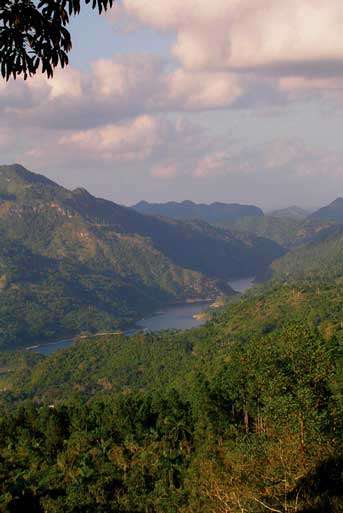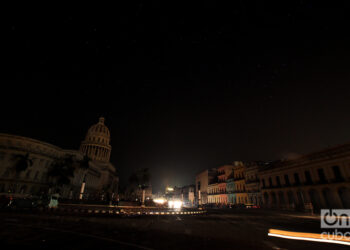Photos: Author
The ATV that we’d rented for the occasion rolled through the green mountains; we moved from mountain tops to the bottom of a river valley, and I later learned that those currents shape the nearby hollows, running through caves and narrow canyons. Our destination was Topes de Collantes. We were coming from the beautiful city of Trinidad and its Valle de los Ingenios, or “Valley of the Sugar Mills,” which was declared a World Heritage Site twenty-four years ago.
We reached to the Hotel Los Helechos at nightfall, after arriving at the high plateau of Topes de Collantes, where our GPS showed that we were at about 2,625 feet above sea level.
A lovely guide explained to us that the main characteristics of this nature reserve are its mountains, unique forests, a microclimate of 69.8 degrees Fahrenheit, an extremely large percentage of endemic flora and fauna, and an abundance of crystal-clear rivers, featuring picturesque waterfalls and natural pools. Full of expectations, we went to bed exhausted.
At sunrise, we head out for the River Caburní Falls. Right in the center of the plateau is a giant sundial, amazing for its uniqueness. About 328 yards ahead is the village of Caburní, and that is where we start on the path down to the waterfall. At a bend along the way, we are surprised to find the La solapa del elefante, which holds an indigenous archeological site, El gran Solapón, striking for the size of its vault.
From here on, the slopes are as steep as 45 degrees. We continue on for about one and a half miles, and after just a few slips, we make it to the Caburní Falls, a national monument.
The water cascades from a height of than 200 feet over a steep rock wall, making a beautiful arc that lands in a crystal-clear pool. After snapping photos nonstop, we jump in for a refreshing, delightful dip.
After midday, we decide to head back. Climbing back up the path we came down is a real odyssey, but it is worth it. Along the way, a Cartacuba (Cuban Tody) flutters its wings.
Back at the Kurhotel, we decide to visit this rural building/art gallery, the country’s most impressive. Inside, this giant facility holds more than 400 works of art, donated by celebrated Cuban artists of the 1980s: Tomás Sánchez, Roberto Fabelo, Flora Fong, Wilfredo Lam, René Portocarrero, Mendive…
On the banks of the River Guaurabo is El Cubano natural park. Riding on beautiful horses, we pass coffee farms and pristine forests before arriving at the Javira reserve, located southeast of Potrerillo Peak and 3,132 feet above sea level. The Javira is a protected natural area of old-growth forests and cool streams, a real paradise for bird-watching. For example, it is one of the few places where you can observe the Catey, or Cuban parakeet, in the wild.
On the way back, we visit the El Cubano farm and its picturesque waterfall, and this second day here ends with lunch at the farm’s restaurant, which specializes in catfish.
To reach the river Vegas Grandes on the third day, we walk northeast of Pico Potrerillo. This river is impressive for the falls that make it famous. On one of its banks, an arboretum was planted with more than 300 exotic and native species and the largest arborescent ferns and mahoganies in Cuba.
On the way back, we have lunch at Mi Retiro, a restaurant located on the edge of a gigantic fluvial valley, which servevs exquisite Cuban dishes. After a delicious Cuban coffee, we head for La Batata cave, located a little less than two miles away. This cave was formed by an underground river that has many pools, some of which are as warm as 68 degrees Fahrenheit and have restorative properties, and which are surrounded by unique scenery.
The fourth day of our journey was intense. A quick jeep ride took us to Codina farm to visit Cueva del Altar, a cave that is literally jam-packed with secondary mineral deposits, or speleotherms. We enter through a passageway that takes us to a skylight and from there to the Vista al Mar lookout spot. It provides a panoramic view of Trinidad, the Ancón Peninsula and the bay of Casilda, all seen through a blue mist that melts into the Caribbean Sea.
Upon returning to the altiplano, an immense truck takes us over the 9.3 miles to Guanayara. We are welcomed by La Gallega, an attentive local woman, with a surprise for each client. Intrigued, we start on the path down to the dense forest, reaching the Poceta del Venado natural swimming pool, where we cannot resist the temptation to dive in for a brief but refreshing dip. A couple of hundred yards further on, nature rewards us with an unexpected waterfall: El Rocío, which cascades over more than 98 feet. When we return at about 4 p.m., we find a smiling La Gallega, who serves steaming Cuban yellow rice and gigantic servings of chicken with salsa to delight our palates.
And that was the end of four days of a special spirituality, contact with the most beautiful side of Cuban nature.







a1_1-75x75.jpg)


Рeculiar article, just what I needеd.